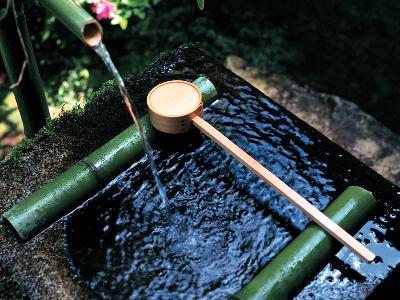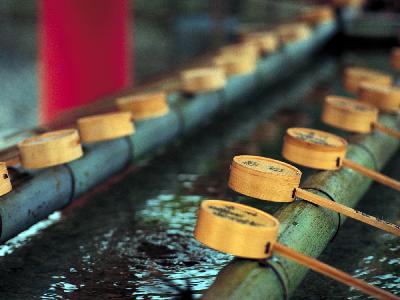|
A hishaku is a utensil traditionally used to scoop water. Hishaku used to be made from bamboo with the handle fashioned from a branch of a tree. These days, they are mostly made of metal or plastic.
The size and use of hishaku vary. Although the wooden magarimono hishaku can only be seen at Temizusha (purification buildings where water is drawn) of shrines and temples, and sometimes at houses that admire Japanese elegance, it used to be a part of everyday life.
The origins of hishaku come from a hisago (gourd), which was broken in half. The word 'hisago' was pronounced in a different accent, becoming 'hisaku', which was then changed again into 'hishaku'.
It was traditionally thought that divine spirits dwell in places that are dented, or caved in, thus the hishaku was treated as a holy container.
Before wakamizumukae (meeting of the first water) on new year's day, people have prepared new hishaku for the drawing of water from a well or spring. The water that is drawn is then placed before the new year's deity, and used to rinse out the mouth, as well as to make ozoni (vegetable soup with rice cakes in it).
Since the hishaku is thought to have special powers, the water that it scoops is used in other ways, for example as holy water to be sprinkled in front of one's house as a talisman against evil and sickness. A hishaku hung from a pot hook acts as a charm to prevent fires.
The size and use of hishaku vary. Although the wooden magarimono hishaku can only be seen at Temizusha (purification buildings where water is drawn) of shrines and temples, and sometimes at houses that admire Japanese elegance, it used to be a part of everyday life.
The origins of hishaku come from a hisago (gourd), which was broken in half. The word 'hisago' was pronounced in a different accent, becoming 'hisaku', which was then changed again into 'hishaku'.
It was traditionally thought that divine spirits dwell in places that are dented, or caved in, thus the hishaku was treated as a holy container.
Before wakamizumukae (meeting of the first water) on new year's day, people have prepared new hishaku for the drawing of water from a well or spring. The water that is drawn is then placed before the new year's deity, and used to rinse out the mouth, as well as to make ozoni (vegetable soup with rice cakes in it).
Since the hishaku is thought to have special powers, the water that it scoops is used in other ways, for example as holy water to be sprinkled in front of one's house as a talisman against evil and sickness. A hishaku hung from a pot hook acts as a charm to prevent fires.
| [+ADDRESS] | 
|














